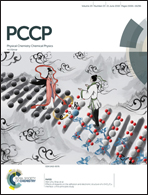Hydrogenation properties of lithium and sodium hydride – closo-borate, [B10H10]2− and [B12H12]2−, composites†
Abstract
The hydrogen absorption properties of metal closo-borate/metal hydride composites, M2B10H10–8MH and M2B12H12–10MH, M = Li or Na, are studied under high hydrogen pressures to understand the formation mechanism of metal borohydrides. The hydrogen storage properties of the composites have been investigated by in situ synchrotron radiation powder X-ray diffraction at p(H2) = 400 bar and by ex situ hydrogen absorption measurements at p(H2) = 526 to 998 bar. The in situ experiments reveal the formation of crystalline intermediates before metal borohydrides (MBH4) are formed. On the contrary, the M2B12H12–10MH (M = Li and Na) systems show no formation of the metal borohydride at T = 400 °C and p(H2) = 537 to 970 bar. 11B MAS NMR of the M2B10H10–8MH composites reveal that the molar ratio of LiBH4 or NaBH4 and the remaining B species is 1 : 0.63 and 1 : 0.21, respectively. Solution and solid-state 11B NMR spectra reveal new intermediates with a B : H ratio close to 1 : 1. Our results indicate that the M2B10H10 (M = Li, Na) salts display a higher reactivity towards hydrogen in the presence of metal hydrides compared to the corresponding [B12H12]2− composites, which represents an important step towards understanding the factors that determine the stability and reversibility of high hydrogen capacity metal borohydrides for hydrogen storage.
![Graphical abstract: Hydrogenation properties of lithium and sodium hydride – closo-borate, [B10H10]2− and [B12H12]2−, composites](/en/Image/Get?imageInfo.ImageType=GA&imageInfo.ImageIdentifier.ManuscriptID=C7CP07776A&imageInfo.ImageIdentifier.Year=2018)


 Please wait while we load your content...
Please wait while we load your content...